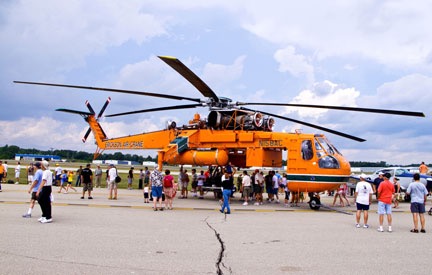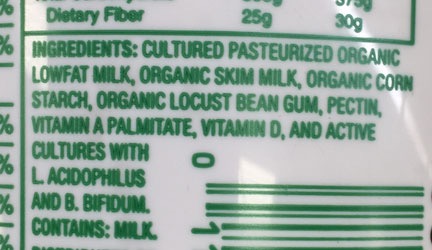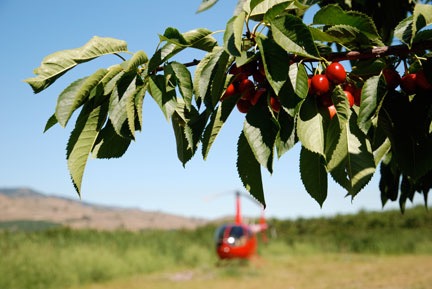Downsizing…because I can.
One of the great things about being single — and believe me, there are lots of great things — is the fact that you simply don’t need as much living space. While two might be able to live as cheaply as one, two can never live comfortably in as little space as one. So not only can I live in a smaller home (1200 square feet vs. 2400 square feet), but I can also travel with a much smaller RV.
And travel is something I love to do. Whether for a weekend, a week, or an entire season, nothing beats hitting the road and exploring new places or revisiting old places with friends. That just wasn’t as easy as it should be when I was towing a 36-foot fifth wheel with four slides. Yes, when I parked, I was extremely comfortable, with enough living space to throw a party for a dozen friends. But getting the damn thing parked took a lot more effort than I wanted to put into it. And finding a place where it could fit wasn’t always easy.
I bought the Mobile Mansion back in 2010, after my then-husband promised he’d hit the road with me during the summer months when I came north for cherry drying. I needed enough space for two full-sized people and a mid-sized dog to live comfortably for four to six months. The Mobile Mansion was perfect for that use. Unfortunately, I wound up not needing all that space, since my husband apparently had no intention of joining me as he’d promised. In 2012, he started the wheels turning to become my wasband. (That turned out to be the best thing that happened to me in a very long time.)
I lived in the Mobile Mansion while I built my new home — so it was a very good thing I had it. It was comfortable, except during the winter months when I made other arrangements. Last summer, after moving into my new home, I used it as an AirBnB rental parked right on my driveway, getting $79/night with a two night minimum almost every weekend from July 4th through October 15. Then it went on a sale lot in East Wenatchee.
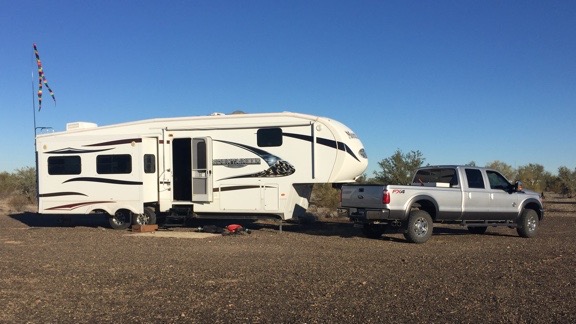 The Mobile Mansion parked in the desert near Quartzite in January 2016.
The Mobile Mansion parked in the desert near Quartzite in January 2016.
By December, I decided to spend the winter snowbirding and fetched it off the lot for a trip south. I spent a happy six weeks in Arizona, Nevada, and California, living mostly off the grid along the Colorado River with friends between stays in another friend’s guest house. Truck problems got it stuck in California for a while, but I brought it home again last month, cleaned it up again, and put it on a sale lot in North Wenatchee.
Over the winter, I’d been thinking hard about options for replacing the Mobile Mansion with something smaller and easier to travel with. My first inclination had been to go with a small — think 16 to 20 feet — bumper pull trailer. Then I happened to take a look at a truck camper for sale in Quartzsite. I struck a deal to trade the Mobile Mansion for the camper and pocket about $12,000, but I hesitated. I hadn’t wrapped my brain around the huge downsizing yet. By the time I was ready — only a week later! — the rig was gone. So I stuck with the Mobile Mansion for the rest of the winter.
But that truck camper had planted a seed. When I got home and placed the Mobile Mansion in the sale lot, I started looking for a truck camper I could live with.
My truck is huge. It’s a 1-ton diesel with 4WD, a crew cab, and a long bed. They don’t get much bigger than this and still fit in a regular garage. Because of its size, I could get a large truck camper. In fact, I sort of had to get a large truck camper.
I looked at a few dealer lots in the Tri-Cities area, then started combing Craig’s List. And that’s when I found the 2005 Lance in Moses Lake.
I went down to look at it. Moses Lake is about a 90-minute drive, although it’s only 55 miles away. The couple who owned it were the original owners and they had taken very good care of it. It was parked in an RV garage when I saw it. It was clean and it was loaded.
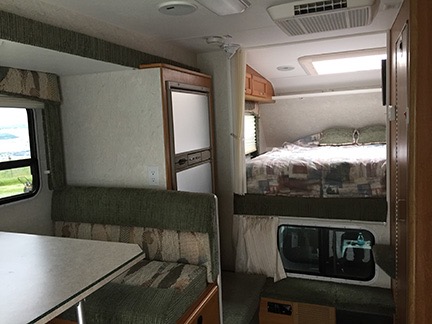
The dinette and refrigerator are on the slide.
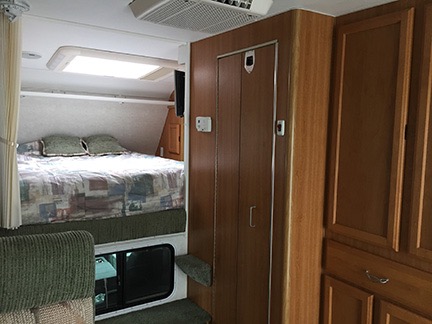
There’s plenty of storage beside the bathroom.
Want a list of features? Here are the highlights: slide for dinette and large refrigerator with separate freezer, queen sized bed, double sink, convection microwave, three-burner stove, television, satellite dish antenna, regular antenna, AM/FM stereo with CD/DVD player, landing gear with remote, two awnings, 2500 watt generator that can be started with the push of a button, tons of storage, skylight in bedroom, lots of windows, day/night shades on most windows (they’re not allowed in kitchen areas, probably due to fire hazard near stove), outdoor shower, wet bathroom (that’s where you shower in the same space as the toilet and sink), air conditioning, heat, two 7-gallon propane tanks, ladder to roof, solar panel that keeps the batteries charged. These are just the things I can think of off the top of my head. The slide is quite large — when it’s open, there’s a ton of floor space. So even if I did happen to go camping with a friend, we wouldn’t be tripping over each other.
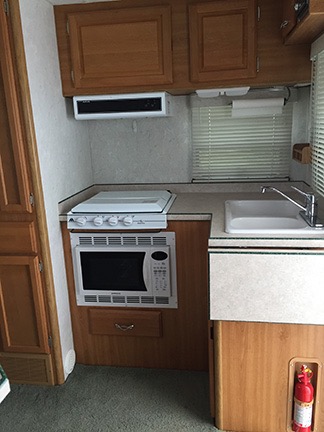
The kitchen is small but functional.

“Wet bath” means you shower in the same space as the toilet and sink.
The price was a bit more than I wanted to spend, but it was in line with Nada RV Guide pricing for a unit its age. And it was in very good condition. The couple was nice. They clearly loved the RV and had made a lot of memories in it. They were sad to sell it. But they’d just bought a fifth wheel almost as big as mine and although they thought they’d use the truck camper once in a while, they realized they wouldn’t. After a year of owning both, they’d decided to sell.
We talked money. I suggested lower price. I hate haggling but he accepted my offer. I got the feeling that they wanted to sell it to me.
I told them I needed to sleep on it and research the truck modifications I’d need to get done to get the camper fastened down on my truck. On the way home, I stopped for dinner at Cave B Winery. Before I was done, I’d decided.
It took me two weeks to get the hardware I’d need on the truck installed. In the meantime, I built a small trailer for the 100LL fuel tank that was in the back of my truck and had the tank moved to it. The tank would come in handy in Quincy, where two pilots would be working for me in June. Then more delays as I had a multi-day aerial photo gig for a favorite client in the area. Finally, with rain forecasted for Wednesday, May 4, I called the owners and made arrangements to meet with them.
The owners were just as gracious to me that day as they were when I first came to see the camper. The husband spent at least an hour with me, showing me how to hook it up and pointing out all kinds of things I’d need to know. (Of course, they had all manuals for the camper gathered up in an envelope under one of the dinette benches.) He backed the truck up under the camper, gave me a wooden rig he used as a spacer to prevent himself from backing up too far, and showed me how to retract the legs. Then we pulled it out onto his driveway and fastened it down to my truck, using fasteners he threw in at no extra charge. Then, while I was doing the paperwork with his wife, he checked my tire pressures and even added air to the airbags at the back end of my truck. Before I left, he took a picture of it — he said he wanted to show his friends the truck he’d put it on. Oddly enough, he has the same truck as me — just one year newer.
When we were all done, we parted ways and I started the long trip home.
The camper, which probably weighs about 3,000 pounds, rides well on back of my truck. I can definitely feel its weight and the higher center of gravity. But my truck gets much better mileage than when I towed the Mobile Mansion and parking it was no trouble at all.
After a stop for lunch in a neat little bistro in George, WA, and a quick trip to the supermarket, I drove over to the RV dealer where I’d left the Mobile Mansion. Way back when I first bought it, I’d replaced the mattress and I wanted to swap them out. That done, I made a stop to pick up some oil for the helicopter before heading home.
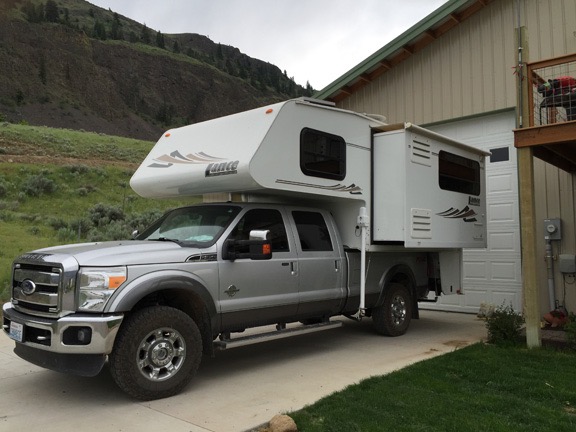
The Turtleback, parked in my driveway with the slide out. And yes, it will fit in the RV garage. After all, the Mobile Mansion fit in there and this is a heck of a lot smaller.
I spent a few hours loading some of the Mobile Mansion’s gear — hoses, cords, cookware, dishes, etc. — into the new RV, which I’d christened the Turtleback on the long drive home. I still need to make the bed and store some extra linens. Most of what I needed from the Mobile Mansion fits into the Turtleback — it has a surprising amount of storage space.
At this point, I’m thinking about taking it up to the National Forest at Leavenworth for a few days on a maiden voyage. There’s a nice campground about 17 miles up Icicle Creek with a good 3-mile loop trail running through it. I’m sure it will be mostly empty mid-week. If I go, I’ll report back here.

